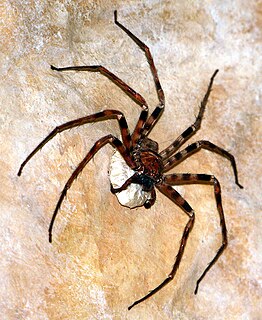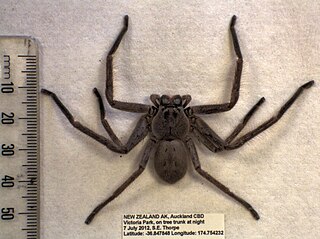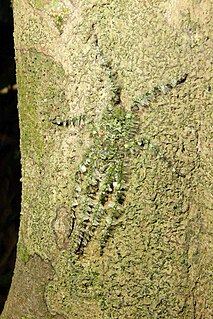
Atracidae is a family of mygalomorph spiders, commonly known as Australian funnel-web spiders or atracids. It has been included as a subfamily of the Hexathelidae, but is now recognized as a separate family. All members of the family are native to Australia. Atracidae consists of three genera: Atrax, Hadronyche, and Illawarra, comprising 35 species. Some members of the family produce venom that is dangerous to humans, and bites by spiders of six of the species have caused severe injuries to victims. The bites of the Sydney funnel-web spider and northern tree-dwelling funnel-web spider are potentially deadly, but no fatalities have occurred since the introduction of modern first-aid techniques and antivenom.

Huntsman spiders, members of the family Sparassidae, are known by this name because of their speed and mode of hunting. They are also called giant crab spiders because of their size and appearance. Larger species sometimes are referred to as wood spiders, because of their preference for woody places. In southern Africa the genus Palystes are known as rain spiders or lizard-eating spiders. Commonly, they are confused with baboon spiders from the Mygalomorphae infraorder, which are not closely related.

Austracantha is a genus of spider with a single species, Austracantha minax, commonly known as the jewel spider or the Christmas spider. It is a member of the family Araneidae and is endemic to Australia. They are relatively small spiders, reaching a maximum total body length of only around 12 mm (0.47 in) for females, and 5 mm (0.20 in) for males. Their abdomen has six distinctive projections ("spines") that makes them easy to identify. They are predominantly a shiny black, with variable white, yellow, and orange patterns. Melanistic forms also occur during autumn. They are facultatively gregarious, and can be found in large aggregations of overlapping orb webs. They feed on small flying insects that get entangled in their webs. They are harmless to humans, though the webs can be a nuisance for bushwalkers. They are most abundant during the summer months.

Ludwig Carl Christian Koch was a German entomologist and arachnologist.

Clynotis is a genus of spiders in the family Salticidae, or jumping spiders, contained within the subfamily Marpissinae. They are found across Australia and New Zealand, with some species occupying the Auckland Islands and one found exclusively on Snares Island. There are eight species currently described within the genus, the earliest noted being the type species Clynotis severus, first described in Queensland, New South Wales, Australia in 1879 by Ludwig Carl Christian Koch. The most recent was described in 1931 by Lucien Berland. Two other species previously held within the genus were subsequently reclassified into the genus Tara.

The giant huntsman spider is a species of the huntsman spider family Sparassidae found in Laos. It is considered the world's largest spider by leg span, which can reach up to 30 cm (1 ft).

Heteropoda cervina, commonly called the brown huntsman, is a large species of spider in the family Sparassidae often found in leaf litter in central Queensland, Australia. The species was first described by Ludwig Carl Christian Koch in 1875 as Sarotes cervinus.

Holconia is a genus of South Pacific huntsman spiders that was first described by Tamerlan Thorell in 1877. It was branched from Isopeda in 1990.

Isopeda villosa is a species of huntsman spider native to New South Wales, Australia, and established in Auckland, New Zealand. It was first described by Ludwig Carl Christian Koch in 1875.

Isopeda is a genus of huntsman spiders that was first described by Ludwig Carl Christian Koch in 1875.

Argoctenus is a genus of South Pacific long-legged sac spiders first described by Ludwig Carl Christian Koch in 1878. They are found in Australia, New Zealand, and New Guinea. They resemble wolf spiders except for the narrowed carapace and the eye arrangement.

Pandercetes is a genus of huntsman spiders that was first described by Ludwig Carl Christian Koch in his 1875 treatise on Australian spiders. They are mainly distributed in tropical Asia and Australia, and are known for their cryptic coloration that matches local moss and lichen. Their legs have lateral hairs, giving them a feathery appearance, further masking their outline against tree trunks. Their head is somewhat elevated and the carapace has the thoracic region low and flat.

Beregama is a genus of South Pacific huntsman spiders that was first described by D. B. Hirst in 1990.
Exopalystes is a monotypic genus of Papuan huntsman spiders containing the single species, Exopalystes pulchellus. It was first described by Henry Roughton Hogg in 1914, and is found in Papua New Guinea.

Neosparassus is a genus of huntsman spiders first described by Henry Roughton Hogg in 1903. Members of this genus most closely resemble those of Heteropoda, except that the cephalothorax is high, peaking between the midpoint and the eyes, before sloping toward the back. This angle causes the front of these spiders to appear more prominent than it actually is.
Prychia is a genus of huntsman spiders that was first described by Ludwig Carl Christian Koch in 1875.
Zachria is a genus of Australian huntsman spiders that was first described by Ludwig Carl Christian Koch in 1875. As of September 2019 it contains two species, found in New South Wales and Western Australia: Z. flavicoma and Z. oblonga. It is not a senior synonym of Eodelena.

Hoggicosa is a genus of wolf spiders first described by Carl Friedrich Roewer in 1960. The name is a reference to arachnologist Henry Roughton Hogg.

Hedana is a genus of crab spiders that was first described by Ludwig Carl Christian Koch in 1874.

















